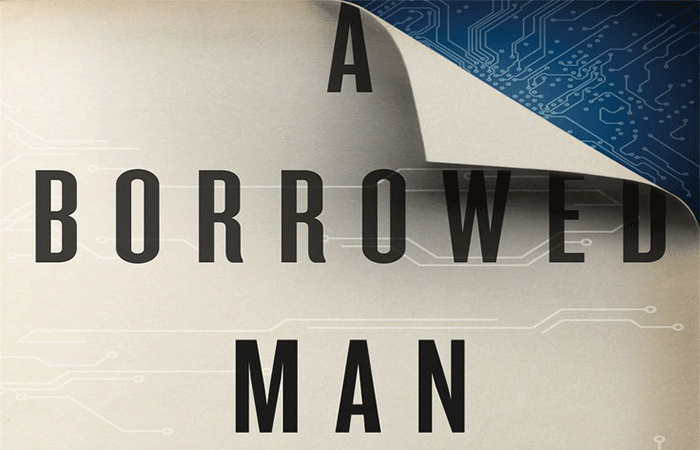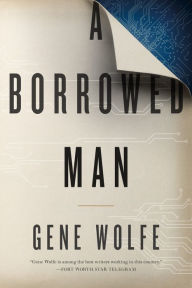Gene Wolfe’s A Borrowed Man Is a Sci-Fi Mystery with No Borrowed Ideas
 At the age of 83, SFWA Grand Master Gene Wolfe is not only still writing, he’s writing stories that are better than most writers in their prime could hope to dream up. In a career that has spanned more than four decades, Wolfe has created truly iconic works of science fiction and fantasy, including The Book of the New Sun series, one of the best-regarded SFF novels in history: dense, complex, and filled with incredible ideas.
At the age of 83, SFWA Grand Master Gene Wolfe is not only still writing, he’s writing stories that are better than most writers in their prime could hope to dream up. In a career that has spanned more than four decades, Wolfe has created truly iconic works of science fiction and fantasy, including The Book of the New Sun series, one of the best-regarded SFF novels in history: dense, complex, and filled with incredible ideas.
Wolfe’s latest, A Borrowed Man, is, as usual, wholly surprising and unexpected. It’s a book of layers that slowly reveals itself, gradually widening our view of an original and disturbing future world; a book that changes chameleon-like every few chapters, wriggling in your hands as you read. Starting as a cozy mystery and mutating into a near-dystopian exploration of a dying Earth, it is fantastic science fiction and, above all else, fantastic Gene Wolfe.
A Borrowed Man
A Borrowed Man
By Gene Wolfe
Hardcover $25.99
Top Layer: Cozy
Our narrator and protagonist is Ern A. Smithe, an author of mystery novels. Or, more accurately, he is a “reclone” of Smithe, generated from his DNA, with his memories and thought processes intact. He lives at the library, along with several other reclone assets, and can be consulted or borrowed. Let’s consider this idea for a moment: imagine Charles Dickens could be cloned with his life experience intact, but then the lifespan of that clone was confined to the New York Public Library, to be used as living research. And Dickens would be one of the lucky ones—reclones who aren’t consulted or borrowed often enough are destroyed.
Smithe is bored and restless in his little library cubby until he’s checked out by a wealthy heiress, Colette Coldbrook. She tells Smithe that her brother and father have both been killed, and she believes the crimes have something to do with a copy of one of Smithe’s books, found in her father’s safe. She hopes to figure out the secret by literally consulting the author. Smithe and Colette have a good chemistry, but Smithe is always aware of not being “fully human;” he has no rights, and while he finds the adventure and freedom of working with Colette exciting, he is also frequently frustrated by his limitations.
Middle Layer: Dystopia
The book’s early goings are like a standard murder mystery from a bygone era with a few science-fiction frills, but Wolfe ingeniously peels back the top layer with a gradual revelation of details that make this universe darkly fascinating. The world population has shrunk to barely 1 billion people; Smithe describes humanity as “tired,” and at one point Colette points out that while countries still have the knowledge to build terrible weapons of war, they no longer have the resources or the personnel to do so. People with physical or mental defects are imprisoned, and while there is incredible technology on display, there is also bored inhumanity—consider the reclones, who have every thought and emotion of a human but are considered so expendable they are literally burned to death when their usefulness is at an end.
Almost every representative of legitimate authority, from the police to government agents, are presented as corrupt and lawless—almost as gangsters. The net effect is a world where the rich can own personal flying machines, but everything seems to be winding down, losing steam, and falling apart in awful slow motion. That Wolfe manages to convey this without a single “infodump” means the novel requires patience—but it’s patience well rewarded.
Bottom Layer: Brutality
The final solution to the mystery delves deeper into the hollow soul of future humanity, and incorporates even more science fictional content. Smithe is forced to make a brutal choice if he wants to save Colette and ensure his own usefulness. Wolfe’s characters, human and clone alike, act out of sheer self-preservation and a primitive desire for survival. It’s all presented in terms both cozy and polite (indeed, Smithe is forced by neurological programming to speak as he wrote while living: a bit stilted and overly polite) but underneath it’s bleak, and sad, and powerful.
Wolfe has stated he’s working on a sequel to A Borrowed Man titled Interlibrary Loan, and we’re looking forward to it. So should you.
Top Layer: Cozy
Our narrator and protagonist is Ern A. Smithe, an author of mystery novels. Or, more accurately, he is a “reclone” of Smithe, generated from his DNA, with his memories and thought processes intact. He lives at the library, along with several other reclone assets, and can be consulted or borrowed. Let’s consider this idea for a moment: imagine Charles Dickens could be cloned with his life experience intact, but then the lifespan of that clone was confined to the New York Public Library, to be used as living research. And Dickens would be one of the lucky ones—reclones who aren’t consulted or borrowed often enough are destroyed.
Smithe is bored and restless in his little library cubby until he’s checked out by a wealthy heiress, Colette Coldbrook. She tells Smithe that her brother and father have both been killed, and she believes the crimes have something to do with a copy of one of Smithe’s books, found in her father’s safe. She hopes to figure out the secret by literally consulting the author. Smithe and Colette have a good chemistry, but Smithe is always aware of not being “fully human;” he has no rights, and while he finds the adventure and freedom of working with Colette exciting, he is also frequently frustrated by his limitations.
Middle Layer: Dystopia
The book’s early goings are like a standard murder mystery from a bygone era with a few science-fiction frills, but Wolfe ingeniously peels back the top layer with a gradual revelation of details that make this universe darkly fascinating. The world population has shrunk to barely 1 billion people; Smithe describes humanity as “tired,” and at one point Colette points out that while countries still have the knowledge to build terrible weapons of war, they no longer have the resources or the personnel to do so. People with physical or mental defects are imprisoned, and while there is incredible technology on display, there is also bored inhumanity—consider the reclones, who have every thought and emotion of a human but are considered so expendable they are literally burned to death when their usefulness is at an end.
Almost every representative of legitimate authority, from the police to government agents, are presented as corrupt and lawless—almost as gangsters. The net effect is a world where the rich can own personal flying machines, but everything seems to be winding down, losing steam, and falling apart in awful slow motion. That Wolfe manages to convey this without a single “infodump” means the novel requires patience—but it’s patience well rewarded.
Bottom Layer: Brutality
The final solution to the mystery delves deeper into the hollow soul of future humanity, and incorporates even more science fictional content. Smithe is forced to make a brutal choice if he wants to save Colette and ensure his own usefulness. Wolfe’s characters, human and clone alike, act out of sheer self-preservation and a primitive desire for survival. It’s all presented in terms both cozy and polite (indeed, Smithe is forced by neurological programming to speak as he wrote while living: a bit stilted and overly polite) but underneath it’s bleak, and sad, and powerful.
Wolfe has stated he’s working on a sequel to A Borrowed Man titled Interlibrary Loan, and we’re looking forward to it. So should you.
